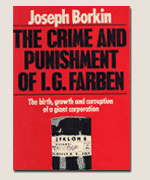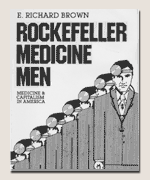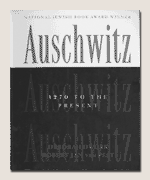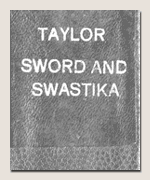Inne ciekawe książki niedostępne w Sieci
 |
The Crime And Punishment of I.G. Farben From 1938 to 1946, Joseph Borkin was the chief of the Patent and Cartel section of the Antitrust Division of the Department of Justice in Washington, and was responsible for the wartime investigation and prosecution of the cartels dominated by I. G. Farben. During the war, he published Germany's Master Plan which led the Associated Press to say: "Joseph Borkin probably knows more about I. G. than anyone outside of it". Since 1946, Mr Borkin has practised Law in Washington and he has written numerous books and articles. He is chairman of the Federal Bar Association's Committee on Standards and Judicial Behaviour, a lecturer in the Catholic University Law School, and Director of the Drew Pearson Foundation. |
 |
Rockefeller Medicine Men - When Rockefeller Medicine Men was first published in 1979, it proved to be a controversial work. In reviewing histories of medicine from 1962 to 1982, Ronald L. Numbers called it "the most controversial medical history of the past decade". Part of the controversy generated by the book comes from its social-historical approach to medicine. The growing body of social histories of health-care challenges the "great physician" perspective that for so long has dominated the history of medicine. In his book, E. Richard Brown describes the political economy of health care, integrating material from a variety of disciplines - economics, sociology, political science, epidemiology, history and social policy. |
 |
Auschwitz: 1270 to the Present No symbol of the Holocaust is more profound than Auschwitz. Yet the sheer, erushing number of murders - over 1,200,000 of them - the overwhelming scale of the crime, and the vast, abandoned site of ruined chimneys and rusting barbed wire isolate Auschwitz from us. How could an ordinary town become a site of such terror? Why was this particular town chosen? Who conceived, ereated, and constructed the camp? This unprecedented history reveals how an unmarkable Polish village was transformed into a killing field. Using architechtural designs and planning documents recently discovered in Poland and Russia and over 200 illustrations, the definitive "Auschwitz: 1270 to the Present" traces the successive stages of how Auschwitz became the focus of a Germanized Poland and the epicenter of the Final Solution. |
 |
Sword and Swastika As chief of counsel for the prosecution of war criminals at Nuremberg, Brigadier General Telford Taylor had a major part in unraveling the tangled knot of guilt for the launching of the war, and for the concomitant atrocities of the Nazi era. In his book, Mr. Taylor takes advantage of his profound knowledge of the Third Reich and of the roles of the German officer class, the industry and the Nazis. |
